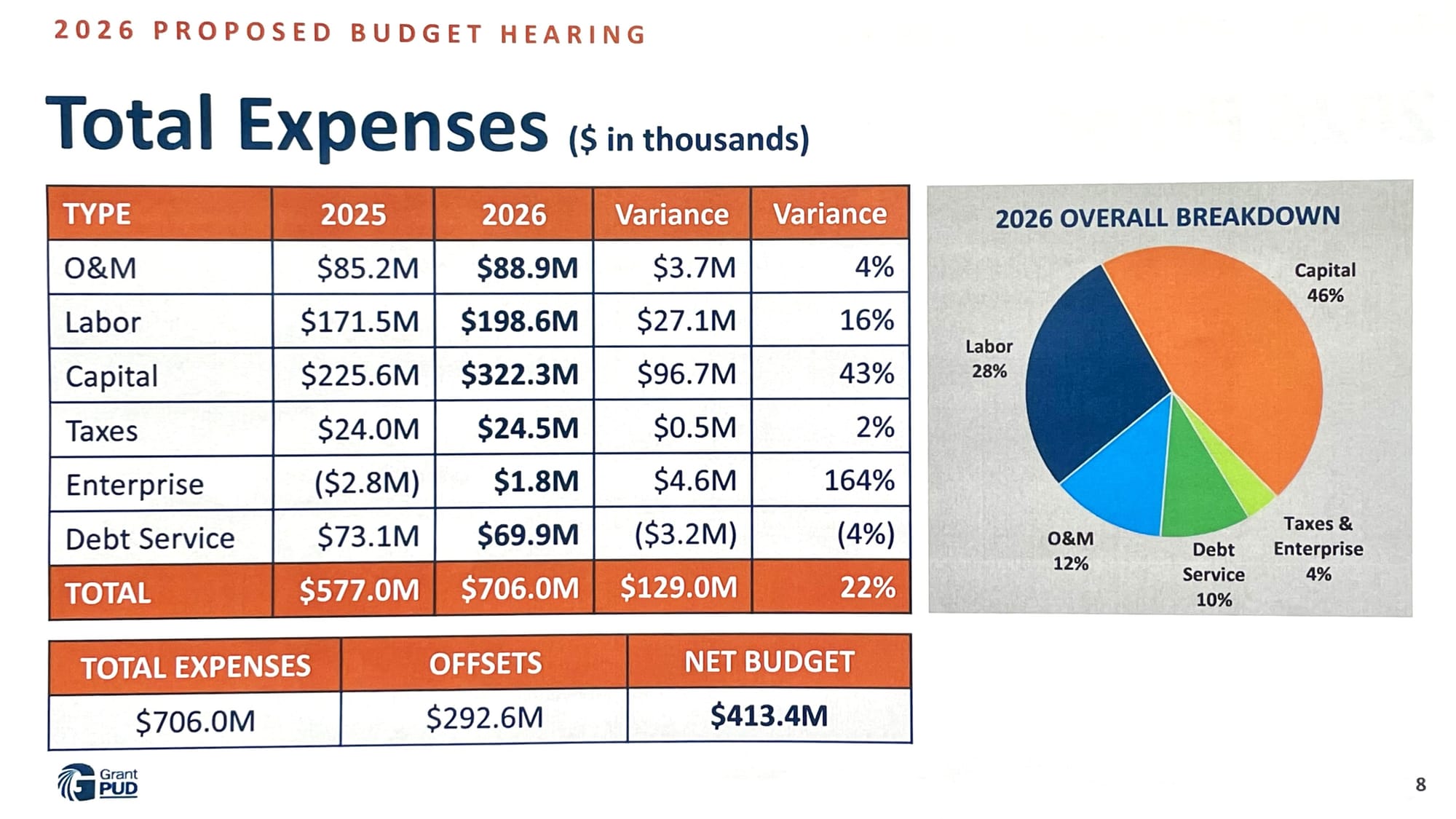Big projects, new hires prompt $101M jump in draft PUD budget

EPHRATA – Grant PUD is proposing to significantly increase its budget in 2026 with plans to hire 88 additional positions, in part to support several multi-million-dollar capital outlay projects that district officials say are needed to provide “long-term value for all customers … (and) low-cost, reliable power for future generations.”
The draft $413.4 million budget reflects a $101.2 million jump over the $312.2 million budget adopted for 2025. The proposal was outlined during two Oct. 14 public hearings and PUD commissioners are tentatively scheduled to adopt it at their Dec. 9 meeting.
Discussions at the budget hearings did not include possible changes in electrical rates. Typically, rate talks are conducted separately with any adjustments, up or down, taking effect in the spring. In recent years, the trend has been toward annual 2% averaged rate hikes with percentages varying within individual rate classes.
By policy, commissioners say they are focused on lower rates for “core customers” – residential, irrigation, and small businesses – with large industrial customers facing larger hikes and paying actual costs for needed infrastructure.
In the coming decade, Grant PUD expects to see its net income “trending down” while having to purchase power at “much higher costs” as demand for electricity exceeds the output of its two hydroelectric dams, explained Bryndon Ecklund, the district’s manager of forecasting and planning.
“Our load will exceed our generation,” he said.
To acquire additional power, the district is partnering in projects for solar-generated electricity and exploring possible future investments in nuclear power, hydrogen, wind and natural gas, PUD general manager/CEO John Mertlich said this summer.
During the initial public hearing on Oct. 14, commissioner Tom Flint indicated the board intends to “look at rates differently” in the future regarding costs related to large industrial development, which drives most of the increased power needs in the county.
A big factor in the 2026 budget increase is capital expenditures, rising a hefty 43% to an estimated $322.3 million. In all, the PUD has about 130 projects to consider, including three topping the $5 million mark that will be paid by customers.
In house, the district’s largest is the “Quincy Transmission Expansion” – a collection of 10 sub-projects with a price tag of $97.3 million that is expected to add 650 megawatts of power capacity while providing “grid flexibility and redundancy.”
Other high-cost, ongoing projects for the PUD include:
-- Beginning the design of a new service center/warehouse facility ($86.9 million) to be constructed south of the Ephrata Walmart near Grant County’s new jail;
-- Installing 38 anchors to stabilize spillways at Priest Rapids Dam on the Columbia River, an estimated $31.4 million, three-year project beginning in 2026;
-- Completing rehabilitation of a turbine/generator unit at Priest Rapids Dam, a $44.5 million project expected to be finished in April. It is the seventh of 10 turbine/generator rehabs planned at the decades-old dam.
-- Completing an upgrade of a 25-mile electrical line in the Ancient Lakes-Frenchman Hills area, tabbed at $17.6 million.
With the work comes the need for additional personnel, said Terrah Bicondova, GCPUD’s budget and reporting manager. She said the district plans to increase its labor force – currently around 890 fulltime regular employees – by 88 new positions in 2026.
The anticipated new hires will include analysts, engineers, contract specialists, IT personnel, and support staff, said Bicondova.
Some of that expansion is driven by clean energy mandates imposed by the state. In all, labor costs are projected at $198.6 million in 2026.
Next year, the utility district’s overall operations and maintenance expenses are expected to rise about $3.7 million, to $88.9 million, due to increases in wages and benefits, insurance premiums, regulatory costs, and customer incentive programs. Other expenses include taxes ($24.5 million) and debt service on long-term financing bonds ($69.9 million).
Overall, the district is estimating total expenditures of $706 million in 2026, lowered by “offsets” of nearly $293 million, for net budget expenses of $413.4 million.
Revenue is forecast at $617.6 million, primarily from retail energy sales ($320 million), net power sales that include wholesale-market revenue ($245.4 million), and “at cost” sales to power purchasers ($34 million). The two latter categories – net power and at-cost sales – are each expected to increase by about $15 million. Fiber optic network sales ($14.1 million) and other miscellaneous income ($4.1 million) round out the district’s revenue projections.
Little public comment was received in person during the first of the two public hearings held earlier this month. But the district continues to accept comments which can be submitted in writing, online, or in person during the commission’s bi-monthly meetings.




